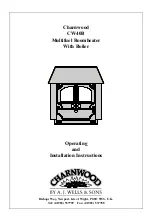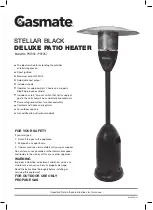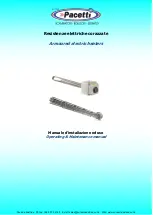
HEALTH AND SAFETY
PRECAUTIONS
Please take care when installing the
appliance that the requirements of the
Health and Safety at Work Act 1974
are met.
Some types of fire cement are caustic
and should not be allowed to come
into contact with the skin. In case of
contact wash with plenty of water.
If there is a possibility of disturbing
any asbestos in the course of
installation then please use
appropriate protective equipment.
There must not be an extractor fan
fitted in the same room as the
appliance as this can cause the
appliance to emit fumes into the
room.
There must be an adequate air supply
into the room in which the appliance
is installed totalling at least 100
square cm. (16 square inches) to
provide combustion air. This is
particularly necessary if the room is
double glazed.
In addition to these instructions the
requirements of BS:8303 and
BS:6461 Pt 1&2; 1984 must be
fulfilled. Local Authority Bylaws and
Building Regulations regarding the
installation of Solid Fuel burning
appliances, flues and chimneys must
also be observed.
PERFORMANCE
The rated output for the CW40B is
3.2kW (11 000 Btu/hr) to the room
and 7.5kW (25 500 Btu/hr) to water.
These are the outputs obtained during
testing in accordance with B.S.3378
burning the standard test fuel with
the doors closed over a 4 hourly
re-fuelling interval.
The heat output to the room is
directly proportional to the heat
output to water as shown in Fig. 3.
This means that if the water heating
load is less than the rated output then
the room heating will be reduced by
the same proportion. This must be
borne in mind when calculating the
heating requirements.
CHIMNEY
In order for the appliance to perform
satisfactorily the chimney height
must not be less than 4 metres
measured vertically from the outlet of
the fire to the top of the chimney.
The chimney should preferably be
175 mm (7 inches) or 200mm (8
inches) internal diameter or square
with sides of 175mm or 200mm
internally and MUST NOT BE LESS
THAN 150mm (6 INCHES)
INTERNAL DIAMETER OR 150 x
150mm INTERNAL SQUARE.
If an existing chimney is to be used it
must be swept and checked, it must
be in good condition, free from
cracks and blockages, and should not
have an excessive cross sectional area
(e.g. greater than 250mm x 250mm).
If you find that the chimney is in
poor condition then expert advice
should be sought regarding the
necessity of having the chimney
lined. If it is found necessary to line
the chimney then a lining suitable for
Solid Fuel must be used.
If there is no existing chimney then a
prefabricated block chimney or a twin
walled insulated stainless steel flue to
BS:4543 can be used either internally
or externally. These chimneys must
be fitted in accordance with the
manufacturers instructions and
Building Regulations.
Single wall flue pipe in vitreous
enamelled steel, stainless steel, or
cast iron is suitable for connecting
the appliance to the chimney but is
not suitable for using for the
complete chimney.
If it is found that there is excessive
draw in the chimney then a draught
stabilizer should be fitted.
HEARTH
The appliance must be installed on a
fireproof hearth and must be situated
at least 300 mm (12 inches) from any
combustible material. The positioning
of the appliance and the size of the
hearth are governed by building
regulations for Class 1 appliances.
These building regulations state that
the hearth must extend in front of the
appliance by at least 300 mm (12
inches) and to the sides by at least
150 mm (6 inches). If in doubt as to
the positioning of the appliance
expert advice should be sought either
from the supplier or the local
building inspector.
INSTALLATION INSTRUCTIONS FOR THE
CHARNWOOD CW40B
Page 7
CW40B 3/95




























